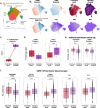This is a preprint.
Tumor-specific draining lymph node CD8 T cells orchestrate an anti-tumor response to neoadjuvant PD-1 immune checkpoint blockade
- PMID: 40501950
- PMCID: PMC12154853
- DOI: 10.1101/2025.04.27.650862
Tumor-specific draining lymph node CD8 T cells orchestrate an anti-tumor response to neoadjuvant PD-1 immune checkpoint blockade
Abstract
Elucidating the anti-tumor role of tumor-draining lymph nodes (tdLNs) in patients could offer critical mechanistic insight and shift therapeutic strategies from a tumor-centric approach to one that considers tumor-immune system interplay. Our study characterizes benign tdLNs T cell anti-tumor responses beyond initial T cell priming in patients with resectable non-small cell lung cancer. We further investigated whether tumor-specific tdLN T cells were altered by immune checkpoint blockade (ICB) locally and systemically. We performed single-cell TCR lineage tracing and transcriptomic profiling on 672,886 CD8 T cells from 41 tumor, benign tdLN, and blood samples in 14 patients treated with or without neoadjuvant chemoimmunotherapy (ChemoIO). Using deep-integrating clonal tracking with machine learning-based transcriptional analysis, our findings revealed that benign tdLNs locally and independently orchestrate two transcriptionally distinct tumor-specific memory CD8 T cell populations: one with ZNF683+ CXCR6+ tumor tissue-residency potential, and another with cytotoxic memory potential. Furthermore, tdLN-derived clones not only constitute the dominant tumor-infiltrating (75%) and circulating (>90%) tumor-specific expanded T cell populations but also preserve their transcriptionally distinct subset identities within the tumor T cell effector state. ChemoIO selectively increased the clonal diversity and cytotoxic memory/TEMRA programs of tdLN-derived clones locally and systemically, both of which remained unchanged in clones lacking tdLN TCR lineage. In conclusion, the tdLN locally orchestrates tumor-reactive and ChemoIO-reactive transcriptional distinct T cell subsets that shape the circulating blood and tumor T cell environments. These findings represent a clinical paradigm shift with implications regarding the extent of tdLN resection during surgery, timing of ChemoIO treatment, and the development of memory T cell-based immunotherapies.
Keywords: Lung cancer; T cells; immunotherapy; single-cell sequencing; tumor-draining lymph nodes.
Conflict of interest statement
Competing interests: All authors declare no potential conflicts.
Figures





References
-
- Gao S., Wu Z., Arnold B., Diamond C., Batchu S., Giudice V., Alemu L., Raffo D. Q., Feng X., Kajigaya S., Barrett J., Ito S., & Young N. S. (2022). Single-cell RNA sequencing coupled to TCR profiling of large granular lymphocyte leukemia T cells. Nature Communications, 13(1), 1982. 10.1038/s41467-022-29175-x - DOI - PMC - PubMed
-
- Pai J. A., Hellmann M. D., Sauter J. L., Mattar M., Rizvi H., Woo H. J., Shah N., Nguyen E. M., Uddin F. Z., Quintanal-Villalonga A., Chan J. M., Manoj P., Allaj V., Baine M. K., Bhanot U. K., Jain M., Linkov I., Meng F., Brown D., … Satpathy A. T. (2023). Lineage tracing reveals clonal progenitors and long-term persistence of tumor-specific T cells during immune checkpoint blockade. Cancer Cell, 41(4), 776–790.e7. 10.1016/j.ccell.2023.03.009 - DOI - PMC - PubMed
-
- Manfredini Beatrice, et al. “The Role of Lymphadenectomy in Early-Stage NSCLC.” Cancers, vol. 15, no. 14, 14, Jan. 2023, p. 3735. www.mdpi.com, 10.3390/cancers15143735. - DOI - PMC - PubMed
-
- Watanabe Shun-ichi, and Asamura Hisao. “Lymph Node Dissection for Lung Cancer: Significance, Strategy, and Technique.” Journal of Thoracic Oncology, vol. 4, no. 5, May 2009, pp. 652–57. www.jto.org, 10.1097/JTO.0b013e31819cce50. - DOI - PubMed
-
- du Bois Haley, et al. “Tumor-Draining Lymph Nodes: At the Crossroads of Metastasis and Immunity.” Science Immunology, vol. 6, no. 63, Sept. 2021, p. eabg3551. science.org (Atypon), 10.1126/sciimmunol.abg3551. - DOI - PMC - PubMed
Publication types
Grants and funding
LinkOut - more resources
Full Text Sources
Research Materials
